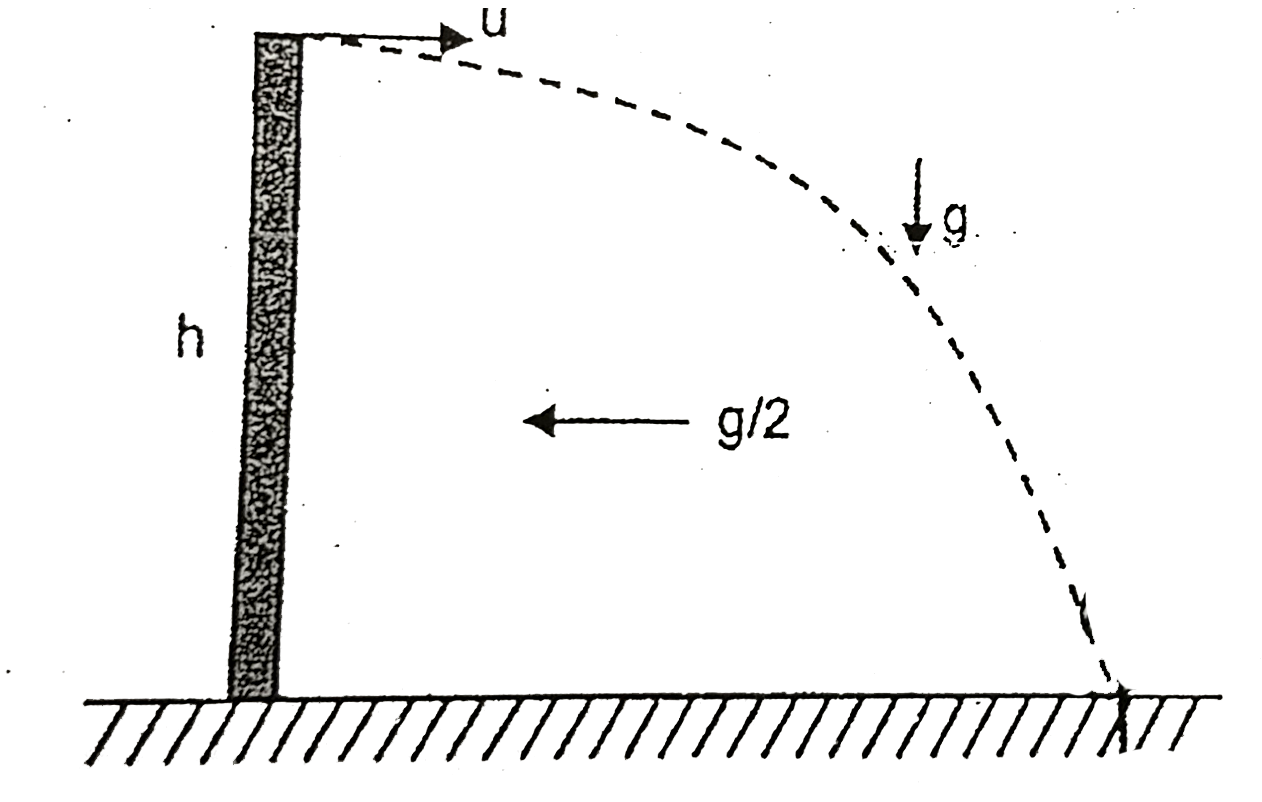Two particles of mass m1 and m2 are projected from the top of a tower. The particle m1 is projected vertically downward with speed u and m2 is projected horizontally with same speed. Find acceleration of CM of system of particles by neglecting the effect of air resistance.
To find the acceleration of the center of mass (CM) of the system of two particles projected from the top of a tower, we can follow these steps:
Step 1: Identify the forces acting on the particles
Both particles m1 and m2 are subjected to gravitational force. The only force acting on them is the weight due to gravity, which acts downward.
Step 2: Determine the acceleration of each particle
Since both particles are in free fall (neglecting air resistance), they will experience the same acceleration due to gravity, denoted as g. Thus:
- The acceleration of particle m1 (which is projected downward) is a1=g (downward).
- The acceleration of particle m2 (which is projected horizontally) is also a2=g (downward).
Step 3: Calculate the acceleration of the center of mass
The formula for the acceleration of the center of mass aCM for a system of particles is given by:
aCM=m1a1+m2a2m1+m2
Substituting the values we have:
aCM=m1⋅g+m2⋅gm1+m2
Step 4: Factor out common terms
We can factor out g from the numerator:
aCM=g(m1+m2)m1+m2
Step 5: Simplify the expression
The m1+m2 terms in the numerator and denominator cancel out:
aCM=g
Step 6: Direction of acceleration
Since both accelerations a1 and a2 are directed downward, we can express the acceleration of the center of mass in vector form as:
aCM=−g^j
where ^j is the unit vector in the upward direction.
Final Answer
Thus, the acceleration of the center of mass of the system of particles is:
−g^j(downward)
Both particles m1 and m2 are subjected to gravitational force. The only force acting on them is the weight due to gravity, which acts downward.
Since both particles are in free fall (neglecting air resistance), they will experience the same acceleration due to gravity, denoted as g. Thus:
- The acceleration of particle m1 (which is projected downward) is a1=g (downward).
- The acceleration of particle m2 (which is projected horizontally) is also a2=g (downward).
The formula for the acceleration of the center of mass aCM for a system of particles is given by:
We can factor out g from the numerator:
The m1+m2 terms in the numerator and denominator cancel out:
Since both accelerations a1 and a2 are directed downward, we can express the acceleration of the center of mass in vector form as:
Thus, the acceleration of the center of mass of the system of particles is:
Topper's Solved these Questions
- CENTRE OF MASSBOOK - DC PANDEY ENGLISHCHAPTER - CENTRE OF MASSEXERCISE - Check points
50 Videos
- CENTRE OF MASSBOOK - DC PANDEY ENGLISHCHAPTER - CENTRE OF MASSEXERCISE - Taking it together
73 Videos
- CALORIMETRY AND HEAT TRANSFERBOOK - DC PANDEY ENGLISHCHAPTER - CALORIMETRY AND HEAT TRANSFEREXERCISE - Medical entrance s gallery
38 Videos
- CENTRE OF MASS, IMPULSE AND MOMENTUMBOOK - DC PANDEY ENGLISHCHAPTER - CENTRE OF MASS, IMPULSE AND MOMENTUMEXERCISE - Comprehension type questions
15 Videos
Similar Questions
A particle is projected vertically upwards in vacuum with a speed u.
View SolutionIf two particles of masses m1 and m2 are projected vertically upwards with speed v1 and v2, then the acceleration of the centre of mass of the system is
View SolutionA particle of mass m is thrown horizontally from the top of a tower and anoher particle of mass 2m is thrown vertically upward. The acceleration of centre of mass is
View SolutionA particle of mass m is thrown horizontally from the top of a tower and anoher particle of mass 2m is thrown vertically upward. The acceleration of centre of mass is
View SolutionA particle projected from ground moves at angle 45∘ with horizontal one second after projection and speed is minimum two seconds after the projection The angle of projection of particle is [ Neglect the effect of air resistance )
View SolutionFrom the top of a tower of height 200m, a ball A is projected up with 10ms−1. And 2s later another ball B is projected verticall down with the same speed. Then .
View SolutionA particle of mass m is projected upword with velocity v=ve2 (ve) escape of the particle is
View SolutionTwo particles A and B are projected simultaneously from a fixed point of the ground. Particle A is projected on a smooth horizontal surface with speed v, while particle B is projected in air with speed v, while particle B is projected in air with speed 2v√3. If particle B hits the particle A, the angle of projection of B with the vertical is
View SolutionA particle is projected with speed 20ms−1 at an angle 30∘ With horizontal. After how much time the angle between velocity and acceleration will be 90∘
View SolutionA particle is projected horizontally from a tower with velocity u towards east. Wind provides constant horizontal acceleration g2 towards west. If particle strikes the ground vertically the then :

View Solution
